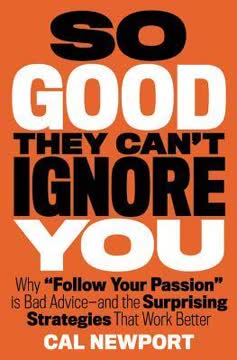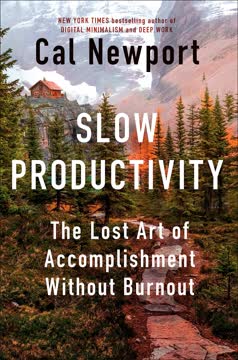Key Takeaways
1. Question Growth: Bigger Isn't Always Better
"Growth, as a primary focus, is not only a bad business strategy, but an entirely harmful one."
Challenge conventional wisdom. The traditional business paradigm teaches that success equals constant growth in revenue, customers, and employees. However, this mindset can lead to premature scaling, unsustainable practices, and eventual failure. Companies that focus solely on growth often struggle with:
- Increased complexity and bureaucracy
- Higher operational costs
- Reduced agility and ability to adapt
- Diminished quality of products or services
- Burnout and decreased employee satisfaction
Embrace "enough". Instead of blindly pursuing growth, companies of one should focus on finding their optimal size and improving efficiency. This approach allows for:
- Sustainable profitability
- Better work-life balance
- Increased focus on customer satisfaction
- More control over business direction
- Reduced environmental impact
2. Embrace the Company of One Mindset
"A company of one is simply a business that questions growth."
Redefine success. A company of one is not about remaining small at all costs, but rather about intentionally choosing the right size for your business. This mindset emphasizes:
- Quality over quantity
- Efficiency and productivity
- Autonomy and self-reliance
- Flexibility and adaptability
- Purpose-driven work
Characteristics of a company of one:
- Resilience: Ability to recover quickly from difficulties
- Autonomy: Control over one's work and decisions
- Speed: Agility in decision-making and execution
- Simplicity: Focus on essential processes and systems
By adopting this mindset, entrepreneurs can create businesses that align with their values, provide fulfilling work, and generate sustainable income without the pressure of constant expansion.
3. Develop Resilience and Autonomy
"Resilient people possess three — absolutely learnable — characteristics."
Build mental toughness. Resilience is crucial for navigating the ups and downs of entrepreneurship. The three key characteristics of resilient people are:
- Acceptance of reality
- Sense of purpose
- Ability to adapt
Foster autonomy. True autonomy comes from mastering your skills and developing the ability to solve problems independently. To increase autonomy:
- Continuously improve your core skills
- Develop a broad skill set (become a "generalist")
- Learn to make decisions confidently
- Take ownership of your work and results
By cultivating resilience and autonomy, companies of one can thrive in challenging environments and maintain control over their business direction.
4. Focus on Profitability, Not Just Revenue
"You can't sell your way out of an unprofitable business."
Prioritize profit. Many businesses mistakenly focus on growth metrics like revenue or user acquisition without considering profitability. Instead, companies of one should:
- Aim for "Minimum Viable Profit" (MVPr) as quickly as possible
- Keep expenses low and operations lean
- Focus on high-margin products or services
- Avoid unnecessary overhead and debt
Strategies for increasing profitability:
- Raise prices strategically
- Improve operational efficiency
- Focus on retention and repeat customers
- Develop multiple income streams
- Invest in automation and scalable systems
By prioritizing profitability from the start, companies of one can achieve sustainable success and financial stability without relying on external funding or aggressive growth strategies.
5. Build Trust and Relationships with Customers
"Customer happiness is the new marketing."
Prioritize customer success. Building strong relationships with customers is crucial for long-term success. Companies of one should focus on:
- Understanding customer needs and pain points
- Providing exceptional customer service
- Creating products or services that truly solve problems
- Fostering a sense of community and belonging
Strategies for building trust:
- Be transparent about your business practices
- Consistently deliver on promises
- Personalize interactions when possible
- Solicit and act on customer feedback
- Share customer success stories
By prioritizing customer relationships and trust, companies of one can create a loyal customer base that drives sustainable growth through word-of-mouth referrals and repeat business.
6. Leverage Scalable Systems and Technology
"Technology has made it easy to do what used to cost thousands or require a team of people."
Embrace automation. Companies of one can significantly increase their efficiency and output by leveraging technology and scalable systems. Key areas to focus on:
- Customer relationship management (CRM)
- Email marketing and automation
- Project management tools
- Accounting and invoicing software
- E-commerce platforms
Benefits of scalable systems:
- Increased productivity
- Reduced human error
- Improved customer experience
- Better data analysis and decision-making
- Ability to handle growth without adding staff
By strategically implementing scalable systems, companies of one can operate efficiently and compete with larger organizations while maintaining their lean structure.
7. Launch Quickly and Iterate Often
"If you aren't embarrassed by the first version of your product, you've launched too late."
Embrace imperfection. The key to success is getting your product or service to market quickly and then improving based on real-world feedback. Benefits of this approach:
- Faster time to market
- Reduced upfront costs
- Ability to validate ideas with real customers
- Continuous improvement based on user feedback
- Increased agility and adaptability
Steps for quick launching:
- Identify the core problem your product solves
- Develop a minimum viable product (MVP)
- Launch to a small group of early adopters
- Gather feedback and iterate rapidly
- Gradually expand your offering and customer base
By launching quickly and iterating often, companies of one can reduce risk, improve their products faster, and build a loyal customer base through continuous engagement and improvement.
8. Teach Everything You Know
"To stand out and build an audience as a company of one, you have to out-teach and outshare the competition, not outscale them."
Share your expertise. Teaching others not only establishes you as an authority in your field but also builds trust and attracts potential customers. Benefits of teaching:
- Increased visibility and credibility
- Stronger relationships with your audience
- Opportunities for content marketing
- Potential for additional revenue streams (courses, books, etc.)
- Continuous learning and improvement of your own skills
Ways to teach and share knowledge:
- Write blog posts or articles
- Create video tutorials
- Host webinars or workshops
- Develop online courses
- Speak at conferences or events
- Write a book or e-book
By freely sharing your knowledge, you create value for your audience and position yourself as a trusted expert in your field.
9. Cultivate Social Capital and Partnerships
"Relationships are currency."
Build a network. Social capital is crucial for the success of a company of one. It provides access to resources, opportunities, and support that can help your business thrive. Benefits of social capital:
- Access to new customers and markets
- Collaborative opportunities
- Emotional support and mentorship
- Increased visibility and credibility
- Resource sharing and cost reduction
Strategies for building social capital:
- Actively participate in industry events and communities
- Offer help and support to others without expecting immediate returns
- Collaborate on projects with complementary businesses
- Share others' content and promote their work
- Build genuine relationships based on mutual interests and values
By cultivating strong relationships and partnerships, companies of one can expand their reach and capabilities without sacrificing their independence or core values.
Last updated:
FAQ
What's Company of One about?
- Focus on Staying Small: Company of One by Paul Jarvis emphasizes the strategic advantage of staying small in business, challenging the conventional belief that growth equals success.
- Redefining Growth: It advocates for a broader definition of growth, including learning, betterment, and contentment, rather than just increasing revenue or customer numbers.
- Personal Autonomy: Jarvis shares insights on creating fulfilling businesses that prioritize personal autonomy and satisfaction over traditional growth metrics.
Why should I read Company of One?
- Alternative Business Model: The book offers a refreshing perspective on entrepreneurship, especially for those disillusioned with the relentless pursuit of growth.
- Real-Life Examples: It includes numerous case studies and personal anecdotes that illustrate the principles of running a company of one.
- Practical Advice: Readers will find actionable strategies for defining their own success and creating a business that thrives without unnecessary complexity.
What are the key takeaways of Company of One?
- Questioning Growth: Jarvis suggests that not all growth is beneficial and that sometimes, less is more.
- Customer-Centric Approach: Emphasizes the importance of treating customers as individuals and focusing on their success.
- Embracing Simplicity: Advocates for simplicity in business operations, encouraging streamlined processes and avoiding unnecessary complexity.
What are the best quotes from Company of One and what do they mean?
- “Growth has been hacked to simply mean ‘more.’”: Highlights the misconception that growth is inherently good, advocating for a more nuanced understanding.
- “Staying small doesn’t have to be a stepping-stone to something else.”: Emphasizes that remaining small can be a valid and fulfilling end goal.
- “You can’t sell your way out of an unprofitable business.”: Underscores the importance of profitability over mere sales volume.
What is a "Company of One" as defined by Paul Jarvis?
- Resisting Traditional Growth: A business model that questions the need for traditional growth metrics, focusing on sustainability and fulfillment.
- Emphasizing Autonomy: Allows individuals to maintain control over their work and life, prioritizing personal satisfaction.
- Building Relationships: Thrives on strong customer relationships, treating each customer as if they are the only one.
How can I determine the right mindset for running a Company of One?
- Define Your Purpose: Understanding your core values and purpose is crucial for guiding business decisions.
- Embrace Resilience: Cultivating resilience allows adaptation to challenges without resorting to traditional growth strategies.
- Focus on Customer Success: Prioritizing customer success will lead to your own success, fostering loyalty and sustainable growth.
What is the concept of Minimum Viable Profit (MVPr) in Company of One?
- Focus on Profitability: MVPr is the point at which a business operates profitably, covering all expenses.
- Lower Expenses: Achieving MVPr quickly involves making strategic decisions about costs and pricing.
- Incremental Growth: Allows for controlled and manageable growth based on actual profits rather than speculative projections.
How does Company of One define customer success?
- Customer-Centric Approach: Focusing on customer success is essential for long-term business viability.
- Building Loyalty: Prioritizing customer success fosters loyalty and turns customers into advocates.
- Empathy in Service: Understanding customer needs leads to better service and stronger relationships.
What are some strategies for building customer relationships mentioned in Company of One?
- Personalized Communication: Personal touches in communication can significantly enhance customer relationships.
- Transparency and Honesty: Being open about business practices builds trust with customers.
- Ongoing Engagement: Regularly checking in with customers and providing value strengthens relationships.
How can I apply the principles of Company of One to my own business?
- Assess Your Goals: Define what success means to you beyond financial metrics.
- Focus on Customer Relationships: Implement strategies to build strong relationships with your customers.
- Iterate and Adapt: Launch products quickly and use customer insights to refine offerings.
What are some common pitfalls to avoid when starting a company of one?
- Overextending Resources: Avoid taking on too much too quickly to prevent burnout and financial strain.
- Neglecting Customer Relationships: Failing to build strong customer relationships can lead to high churn rates.
- Ignoring Feedback: Not listening to customer feedback can result in products or services that miss the mark.
What is the overall philosophy of Company of One?
- Better, Not Bigger: Focuses on quality, customer relationships, and sustainable practices rather than chasing growth.
- Sustainability Over Scale: Advocates for building resilient and sustainable businesses, emphasizing that small can be powerful.
- Empathy and Service: Suggests that understanding and serving customers' needs is key to long-term success.
Review Summary
Company of One receives mixed reviews. Many praise its challenge to growth-oriented business culture, offering insights on staying small and purposeful. Readers appreciate the focus on work-life balance and sustainable success. Some find it repetitive or lacking practical advice for experienced entrepreneurs. The book resonates with those questioning traditional business models, but may disappoint those seeking detailed strategies. Overall, it's seen as thought-provoking for aspiring entrepreneurs and small business owners, though opinions vary on its depth and applicability.
Similar Books










Download PDF
Download EPUB
.epub digital book format is ideal for reading ebooks on phones, tablets, and e-readers.





